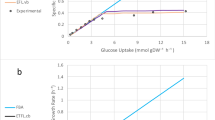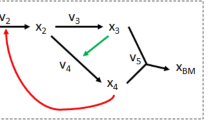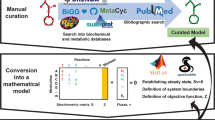Abstract
Mathematical models have become a necessary tool for organizing the rapidly increasing amounts of large-scale data on biochemical pathways and for advanced evaluation of their structure and regulation. Most of these models have addressed specific pathways using either stoichiometric1 or flux-balance analysis2, or fully kinetic Michaelis–Menten representations3, metabolic control analysis4, or biochemical systems theory5,6,7. So far, the predictions of kinetic models have rarely been tested using direct experimentation. Here, we validate experimentally a biochemical systems theoretical model of sphingolipid metabolism in yeast8. Simulations of metabolic fluxes, enzyme deletion and the effects of inositol (a key regulator of phospholipid metabolism) led to predictions that show significant concordance with experimental results generated post hoc. The model also allowed the simulation of the effects of acute perturbations in fatty-acid precursors of sphingolipids, a situation that is not amenable to direct experimentation. The results demonstrate that modelling now allows testable predictions as well as the design and evaluation of hypothetical ‘thought experiments’ that may generate new metabolomic approaches.
This is a preview of subscription content, access via your institution
Access options
Subscribe to this journal
Receive 51 print issues and online access
$199.00 per year
only $3.90 per issue
Buy this article
- Purchase on Springer Link
- Instant access to full article PDF
Prices may be subject to local taxes which are calculated during checkout




Similar content being viewed by others
References
Heinrich, R. & Schuster, S. The Regulation of Cellular Systems (Chapman and Hall, New York, 1996)
Schilling, C. H., Edwards, J. S., Letscher, D. & Palsson, B. O. Combining pathway analysis with flux balance analysis for the comprehensive study of metabolic systems. Biotechnol. Bioeng. 71, 286–306 (2000)
Mulquiney, P. J. & Kuchel, P. W. Modeling Metabolism with Mathematica: Analysis of Human Erythrocyte Metabolism (CRC Press, Boca Raton, Florida, 2003)
Fell, D. A. Understanding the Control of Metabolism (Portland, London, 1997)
Savageau, M. A. Biochemical systems analysis. J. Theor. Biol. 25, 365–379 (1969)
Savageau, M. A. Biochemical Systems Analysis. A Study of Function and Design in Molecular Biology (Addison-Wesley, Reading, Massachusetts, 1976)
Voit, E. O. Computational Analysis of Biochemical Systems. A Practical Guide for Biochemists and Molecular Biologists (Cambridge Univ. Press, Cambridge, 2000)
Alvarez-Vasquez, F., Sims, K. J., Hannun, Y. A. & Voit, E. O. Integration of kinetic information on yeast sphingolipid metabolism in dynamical pathway models. J. Theor. Biol. 226, 265–291 (2004)
Hannun, Y. Functions of ceramide in coordinating cellular responses in stress. Science 274, 1855–1859 (1996)
Hannun, Y. A. & Obeid, L. M. The ceramide-centric universe of lipid-mediated cell regulation: stress encounters of the lipid kind. J. Biol. Chem. 277, 25847–25850 (2002)
Spiegel, S. & Milstien, S. Sphingosine-1-phosphate: an enigmatic signalling lipid. Nature Rev. Mol. Cell Biol. 4, 397–407 (2003)
Hannun, Y. A., Luberto, C. & Argraves, K. M. Enzymes of sphingolipid metabolism: from modular to integrative signaling. Biochemistry 40, 4893–4903 (2001)
Sims, K. J., Spassieva, S. D., Voit, E. O. & Obeid, L. M. Yeast sphingolipid metabolism: clues and connections. Biochem. Cell Biol. 82, 45–61 (2004)
Voit, E. O., Alvarez-Vasquez, F. & Sims, K. J. Analysis of dynamic labeling data. Math. Biosci. 191, 83–99 (2004)
Saba, J. D., Nara, F., Bielawska, A., Garrett, S. & Hannun, Y. A. The BST1 gene of Saccharomyces cerevisiae is the sphingosine-1-phosphate lyase. J. Biol. Chem. 272, 26087–26090 (1997)
Skrzypek, M. S., Nagiec, M. M., Lester, R. L. & Dickson, R. C. Analysis of phosphorylated sphingolipid long-chain bases reveals potential roles in heat stress and growth control in Saccharomyces. J. Bacteriol. 181, 1134–1140 (1999)
Zhang, X., Skrzypek, M. S., Lester, R. L. & Dickson, R. C. Elevation of endogenous sphingolipid long-chain base phosphates kills Saccharomyces cerevisiae cells. Curr. Genet. 40, 221–233 (2001)
Loewen, C. J. et al. Phospholipid metabolism regulated by a transcription factor sensing phosphatidic acid. Science 304, 1644–1647 (2004)
Knudsen, J. et al. Role of acyl-CoA binding protein in acyl-CoA transport, metabolism and cell signaling. Mol. Cell. Biochem. 192, 95–103 (1999)
Shirra, M. et al. Inhibition of acetyl coenzyme A carboxylase activity restores expression of the INO1 gene in a snf1 mutant strain of Saccharomyces cerevisiae. Mol. Cell. Biol. 21, 5710–5722 (2001)
Rasmussen, J., Rosendal, J. & Knudsen, J. Interaction of acyl-CoA binding protein (ACBP) on processes for which acyl-CoA is a substrate, product or inhibitor. Biochem. J. 292, 907–913 (1993)
Mao, C., Wadleigh, M., Jenkins, G. M., Hannun, Y. A. & Obeid, L. M. Identification and characterization of Saccharomyces cerevisiae dihydrosphingosine-1-phosphate phosphatase. J. Biol. Chem. 272, 28690–28694 (1997)
Mandala, S. M. et al. Inhibition of serine palmitoyl-transferase activity by lipoxamycin. J. Antibiot. (Tokyo) 47, 376–379 (1994)
Jenkins, G. M. & Hannun, Y. A. in Apoptosis: A Practical Guide (ed. Studzinski, G. P.) (Oxford Univ. Press, New York, 1999)
Bielawska, J., Szulc, Z. M., Hannun, Y. A. & Bielawska, A. Simultaneous Quantitative Analysis of Bioactive Sphingolipids by High Performance Liquid Chromatography-Tandem Mass Spectroscopy in Methods (ed. Bankaitis, V.) (Academic press, San Diego, in the press)
Ferreira, A. E. N. PLAS for Windows http://correio.cc.fc.ul.pt/~aenf/plas.html (1995)
Acknowledgements
This work was supported by a NIH grant. Doctoral studies of K.J.S. are supported by a NLM training grant. The authors would like to thank C. Mao and S. Vaena de Avalos for helpful discussions and the MUSC Lipidomics Core for sample analysis.Authors' contributions F.A.-V. developed the model and conducted the simulations. K.J.S. performed the experiments under the supervision of Y.O. and drafted the manuscript. L.A.C. performed the inositol experiment. Y.A.H. and E.O.V. conceived and supervised the collaboration and overall strategy of the project, and edited the manuscript.
Author information
Authors and Affiliations
Corresponding authors
Ethics declarations
Competing interests
The authors declare that they have no competing financial interests.
Supplementary information
Supplementary Tables 1 and 2
Supplementary Table 1: Metabolite concentrations. Information taken from the literature for metabolite concentrations in the model. Lists metabolites with model symbol, concentration, comments and references. Supplementary Table 2: Specific activities and kinetic parameters. Information taken from the literature for specific activities and kinetic parameters in the model. Lists enzymes and transporters with model symbol, gene name, specific activity, kinetics values such as Km or Vmax, comments and references. (PDF 402 kb)
Supplementary Text 1
Model design. A brief description of the process of creating a biochemical systems model with an example of equation development using a reaction from sphingolipid metabolism. (DOC 46 kb)
Supplementary Text 2 and Supplementary Figures 1 and 2
Extensions to the prototype model. The rationale for changes made to the prototype model to better predict effects on sphingolipid metabolism. These include the addition and compartmentalization of the complex sphingolipids, the synthesis and elongation of fatty acids, and other small changes. (DOC 65 kb)
Supplementary Text 3 and Supplementary Table 3 and Supplementary Fig. 3
Sensitivity analysis. The methods of sensitivity analysis, with results from this model, (DOC 71 kb)
Supplementary Text 4 and Supplementary Figure 4
Substrate uptake function. The determination of a function for the uptake of labelled substrate. (DOC 27 kb)
Supplementary Text 5
Tracer simulation method and model equations. A method of modelling labelled and unlabelled pools of metabolites. The GMA system of equations for sphingolipid metabolism is given for total, labelled and unlabelled pools using palmitate as the tracer. Also included are the alterations made to the model equations to allow simulation of malonyl-CoA substrate. (DOC 592 kb)
Supplementary Figure 5
Autoradiographs of lipid profiles for wild type and DPL1 knockout strains. (DOC 571 kb)
Rights and permissions
About this article
Cite this article
Alvarez-Vasquez, F., Sims, K., Cowart, L. et al. Simulation and validation of modelled sphingolipid metabolism in Saccharomyces cerevisiae. Nature 433, 425–430 (2005). https://doi.org/10.1038/nature03232
Received:
Accepted:
Issue Date:
DOI: https://doi.org/10.1038/nature03232
This article is cited by
-
Computational modeling of sphingolipid metabolism
BMC Systems Biology (2015)
-
A U-system approach for predicting metabolic behaviors and responses based on an alleged metabolic reaction network
BMC Systems Biology (2014)
-
A genome-scale metabolic model of the lipid-accumulating yeast Yarrowia lipolytica
BMC Systems Biology (2012)
-
Integration of lipidomics and transcriptomics data towards a systems biology model of sphingolipid metabolism
BMC Systems Biology (2011)
-
Genome-wide screen for inositol auxotrophy in Saccharomyces cerevisiae implicates lipid metabolism in stress response signaling
Molecular Genetics and Genomics (2011)
Comments
By submitting a comment you agree to abide by our Terms and Community Guidelines. If you find something abusive or that does not comply with our terms or guidelines please flag it as inappropriate.



